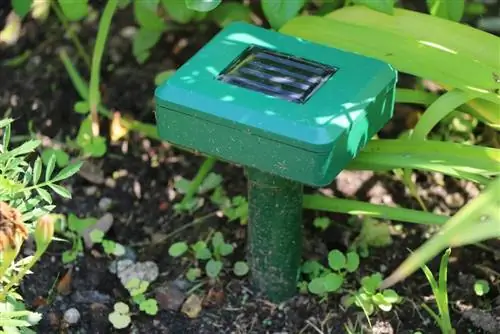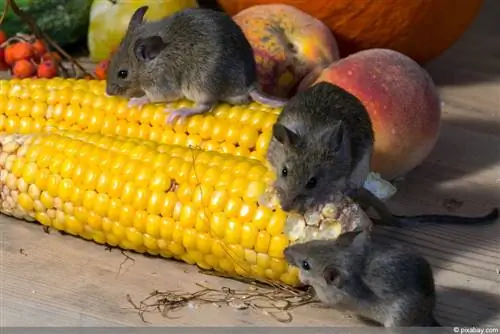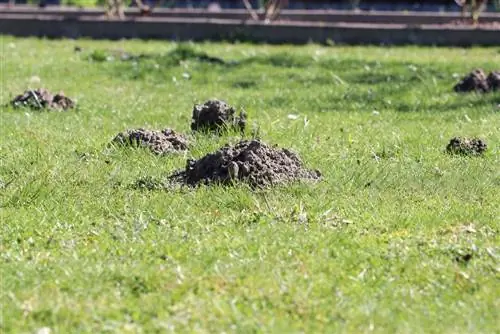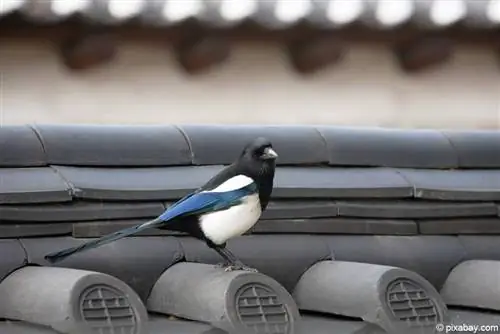- Author admin [email protected].
- Public 2024-01-31 11:14.
- Last modified 2025-01-24 12:45.
Anyone who has a mole in their garden should actually be happy: Just like earthworms, a mole is an indicator of good soil quality. The mole itself is of little concern, but the mounds that are raised are worse - especially in the lawn. That's why the little tunnel builder isn't exactly popular with garden owners. Moles are protected species; they cannot be killed or even caught or relocated. Here you will find all the home remedies in comparison to gently get rid of the mole.
Short profile
- belongs to the family Talpidae
- only species living in Europe: European mole (Talpa europaea)
- belongs to the mammals
- Insect eaters (does not touch plants)
- poor eyesight (differentiation only between light and dark)
- Specially protected under the Federal Species Protection Act
- it is forbidden to catch, injure or even kill him
Lifestyle
A mole spends most of its life in a self-dug, underground tunnel system. Most of the tunnels are located under the main root region close to the soil surface (10-20 centimeters). When there are severe frosts in winter or persistent drought in summer, the mole relocates its activities to greater depths (50 to a maximum of 100 centimeters). The characteristic molehills are created by the excavated material that is pushed to the surface by the mole. The molehills are not located directly above one of the tunnels, but about 15 centimeters to the side of it. Strikingly large molehills, so-called “castles”, serve as a protective barrier against frost above the low-lying nests and food stores.
Like many other animals that live underground, moles do not have a distinct day-night rhythm. Your activity is divided into three phases of waking and sleeping, with the waking phases (of around four to five hours) usually occurring in the morning, afternoon and around midnight. The mole then roams its tunnels in search of food (insects and earthworms). Outside the mating season, a mole is a solitary animal with very pronounced territorial behavior: its territory is on average around 2,000 square meters in size. Moles do not hibernate but are active all year round.
Distinct sensory organs
The cylindrical body of a mole is equipped with large, six-fingered digging shovels and is therefore perfect for life underground. Its eyes are not well developed, but moles are not blind. You can definitely distinguish between light and dark. The other senses are perfectly adapted to life underground: A mole smells and hears very well and can detect even the finest vibrations via its fine tactile hairs.
Repel mole
Since a mole has very developed sensory organs, it quickly feels disturbed by loud noises, unpleasant smells and frequent vibrations in the ground. You can take advantage of this if you want to drive away unwanted garden residents.
Annoying noises

A mole can be gently driven away using acoustic methods (sound waves). In principle, all constructions that produce a sound are possible. They work best when the sound waves are transmitted deep into the ground via a metal rod.
- Bottles buried slightly at an angle in the ground (opening upwards)
- Wind turbines (preferably those that make a slight squeaking sound)
- Sound games: spoons or cans hung on strings that hit a metal stand
- Petrol lawnmower: Mow the lawn twice a week
Tip:
Loud, persistent noises not only disturb the mole, but possibly also the neighbors.
Unpleasant smells
There are a variety of home remedies for annoying odors against a mole. Some remedies for moles in specialist retailers are also based on this mode of action. With all substances, it is crucial that they are distributed evenly throughout the garden. However, simply pouring the odorous substances onto the garden soil is not very effective. The substance must be introduced into the mole's tunnel system for it to work. To do this, an aisle should be opened every few meters and the process repeated about once a week (depending on the weather).
- sour milk
- Buttermilk
- pressed garlic cloves
- crushed branches of the tree of life
- Plant manure (wormwood, nettle, elderflower)
- Fish leftovers
- Imperial crown, daffodils or lilies (planted)
- Pet feces (dog, cat, guinea pig)
- Grate horseradish (hot variety) and mix with water
- Human or animal hair
- Mothballs
- fresh yeast (slurried in warm water)
- Essential oils such as lemon, orange, bergamot or tea tree oil (a few drops)
Tip:
The odorants are most effective when they are added to the aisles and, if possible, distributed throughout the garden. Therefore, this method is very time-consuming and the garden may look worse than if you had let the mole continue working.
Be careful with the following products
There are also some recommendations that should not be used in practice because they are toxic to humans and animals or contaminate the soil and thus destroy the habitat for other plants or animals. These include:
- Chlorine water (poisonous)
- Vinegar: Changes the pH value in the soil (acidification)
- Lye: risk of chemical burns, changes the pH value to alkaline (pH>8)
- Fertilizer: Used very frequently, it leads to over-fertilization
- Petroleum, gasoline: Flammable, sustainably pollutes the soil
- Butyric acid: Causes severe burns
- Calcium carbide: Forms spontaneously flammable gases with water, causes serious eye damage
Shakes

Shakes and certain sounds disrupt the mole's perception and trigger the so-called earthquake escape behavior. The mole sees its own life and that of its offspring at risk and leaves its territory.
- Frequent mowing of the lawn with a petrol lawnmower
- children playing on the lawn
Manual methods
Another, but very time-consuming, method of getting rid of moles from the garden is to flood their burrows with water. Every freshly thrown molehill must be immediately sludged with the garden hose and the passages flooded with water. If this is done very consistently, the mole will leave its territory.
Durable methods against moles
If you keep having moles in your garden, for example because you live on the edge of a field, you should consider whether you would rather strive for a final and permanent solution. It consists of creating a barrier through which the mole cannot get through.
Vertical barrier
With a barrier, moles can be permanently and species-appropriately “fighted” as they are simply prevented from entering the garden. The mole usually only bothers the lawn area, so a vertical barrier can be placed in the ground around the lawn.
- Installation depth: at least 60 centimeters
- Use stable, weather-resistant materials
- All films are suitable for blocking the roots of plants
- Pubble foil
- fine mesh plastic grid
Horizontal lock
If you're creating a new lawn and often have problems with moles, you should install a mole and vole barrier right away. This usually consists of a sturdy grid that is laid out under the root area of the lawn. This allows the mole to move freely around the garden, eat harmful insects and loosen the soil. However, he no longer has the opportunity to produce molehills in the lawn.
Tip:
Do not use nets or weak grids, as these will quickly break and the mole will come back to the surface!
Mole or vole?
If none of the methods work, it may be because the troublemaker in the garden is not a mole, but a vole. The rodents are quite resistant to unpleasant smells and noises. It is easy to distinguish a vole from a mole (even if the animal itself does not show itself):
The molehills are round and relatively high. The entrance to the corridors is in the middle of the hill. In contrast, the mounds of the vole are oval and gently sloped to one side. The hole is offset to the side.
Tip:
If you're not sure, you can stick a carrot in the hill. If it has been nibbled on, it is clearly a vole, as moles do not eat plants.
Conclusion
If you want to gently drive away a mole, you can use various home remedies that are aimed at disturbing the mole's sensitive sensory organs: noises, smells or even vibrations. Many of these methods are only partially effective, very time-consuming or even inconvenience the neighbors. Using toxins in your own garden should be taboo. If the mole keeps coming back, the only solution is a vertical or horizontal barrier in the ground that keeps the mole out of the garden.






